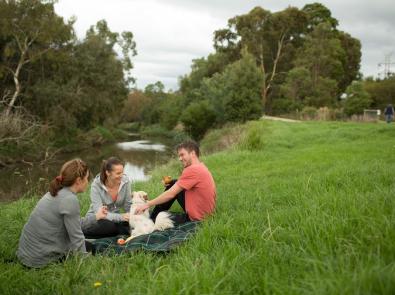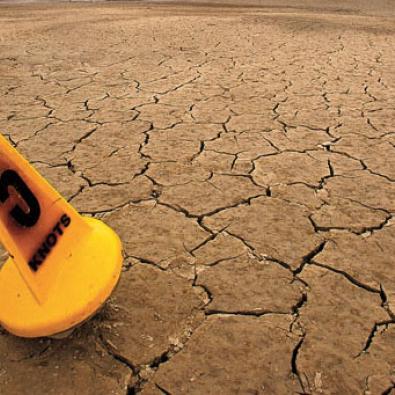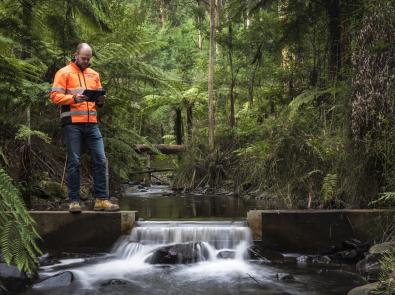We’re adapting our operations to prepare for a changing climate, to ensure we have a secure water supply and provide the services to support a resilient and liveable Melbourne.
Our services are key to Melbourne’s liveability
The services Melbourne Water provides play an important role in making Melbourne a fantastic place to live. It’s our job to ensure we have a secure water supply, a reliable sewerage system and drainage network and healthy rivers and creeks. These services are the foundations of life and liveability in our great city. Climate change has the potential to impact on Melbourne’s liveability.
Our climate is changing
Disruptions in global climate systems are challenging the resilience of Melbourne’s water supply, sewerage treatment, healthy waterways, and drainage and flood management systems. Extreme weather events, rising sea levels, reduced rainfall and increasing temperatures are already affecting infrastructure and water supplies. Our climate will continue to change creating new challenges in the future.
Melbourne is already experiencing and can continue to expect:
- Less rainfall over our catchments, as well as more frequent periods of drought.
- Longer and more severe fire seasons that threaten the quality and quantity of water in our reservoirs.
- Hotter, longer and more frequent heatwaves, increasing stress on waterways, impacting native habitat for biodiversity and community uses, such as recreation.
- Heavier and more frequent downpours and rising sea levels, resulting in more flooding.
How we’re taking action
We know the effects of climate change are already affecting services we provide to the community. That’s why at Melbourne Water we’re taking action on climate change to address these impacts now and adapt to the challenges we will face in the future. We pledge to halve our net emissions by 2025 and reduce them to net zero by 2030. We also commit to sourcing 100% of our electricity from renewables by the end of 2025.
All our services are connected. To build resilience and get better outcomes for the community, environment and economy, we are planning for all services in an integrated way.
For more information about our projects and initiatives to reduce our carbon footprint and generate more renewable energy, visit Our Path to Net Zero page, or contact us.
Securing our water supply
Our water supply is one of the areas where the effects of climate change are most critical. We are already making changes to adapt.
As the climate changes and Melbourne’s population continues to grow, we will need to expand the drinking water supply system to make sure there is enough water to meet the needs of all Melburnians and the Victorian water supply network.
That includes taking an integrated approach to the management of our water supplies. Our strategic plans for healthy waterways, flood management and Melbourne’s sewerage system, all consider how water can be managed across these systems to maximise overall water security in our region.
We are working in collaboration with government and water retailers to manage our water supply now and into the future. Melbourne Water and the water retailers will continue to:
- recycle and reuse more sewage/wastewater for things like agriculture and firefighting
- capture and reuse more stormwater for watering our parks and sporting fields
- support the design of a more water-efficient city.
Desalinated water will continue to be a key part of our water supply, and of course all Melburnians have their role to play, continuing to be water wise in our everyday lives.
Read more about Our water supply challenges.
Transforming our sewerage systems
Melbourne’s sewerage network is facing increasing challenges from both climate change and population growth. To ensure our sewage transfer and treatment systems continue doing their job of protecting community health and our waterways and bays, we need to change how they will operated in the future. We’re working with the metropolitan water companies to identify how our shared networks could transform to become more resilient and continue providing safe reliable sewage services.
Some activities already underway are:
- Examining the possible impacts of sea level rise on waste water infrastructure located near the coastline, so we understand If and how we need to adapt.
- Predicting pressure points in the sewage transfer system under different climate and population scenarios using ‘Our Network Outlook’ tool, so that we can make targeted upgrades or changes. Read more at Integrated Water Management: tool for long-term region-wide outlook.
Protecting and enhancing our waterways
Melbourne’s rivers, creeks and the surrounding open green spaces provide habitat for wildlife, much loved recreational spaces for the community, and help protect water quality. Melbourne Water is researching how climate change may affect our waterways and how we can respond. Some waterway protection and enhancement activities underway are:
- Supporting waterways and wetlands to act as drought refuge sites for native plants and animals. We monitor these sites and take a range of actions during droughts. This can include delivering top-up water.
- Investigating how climate change could reduce groundwater flows and natural flows through our waterways, and how much more 'environmental water' we may need to release to support the plants and animals that live there. Find out more at Water for the environment.
- Researching how climate change may affect the native plants that grow in and alongside our waterways, and how we can make sure the species we plant in the coming decades will survive into the future.
- Creating cooler and greener public places across Melbourne so that they are more enjoyable for more days of the year. We understand the benefits reduced heat and access to shade during summer can have for the health and wellbeing of our communities. So far we’ve provided shade, cooling and greening by planting trees along paths at Jacana and Edithvale wetlands, and we have plans to work with Maribyrnong City Council to do the same along the lower Maribyrnong River regional trail.
Managing flooding and drainage
Melbourne’s drainage and flood management systems will come under increasing pressure from a combination of increasingly severe storm events and rising sea levels. We’re working to map the flooding risks from climate change and plan for, manage and respond to future flooding. Some activities already underway are:
- Updating flood mapping to better understand where new flood risks might occur.
- Working with councils to use updated flood mapping in Planning Schemes to ensure new buildings are designed and constructed in a flood resilient way. We’ve supported Bass Coast and Mornington Councils to include maps of areas affected by storm surges and sea level rise in their Planning Scheme to guide preparedness of coastal developments for future conditions.
- Working in partnership with state and local governments, catchment management authorities, research institutions and Traditional Owners in coastal areas surrounding Port Phillip Bay and Western Port Bay to understand how sea level rise and larger storm surges might affect coastal flooding erosion and salty groundwater intrusion. With the Department of Energy, Environment and Climate Action, we are preparing to share this information to ensure new developments can be built safely and appropriately.
You may also like...
Track climate trends and extremes across Australia with this interactive graph.
CSIRO’s free Water Book covers the status of Australia’s water resources and their future prospects.



